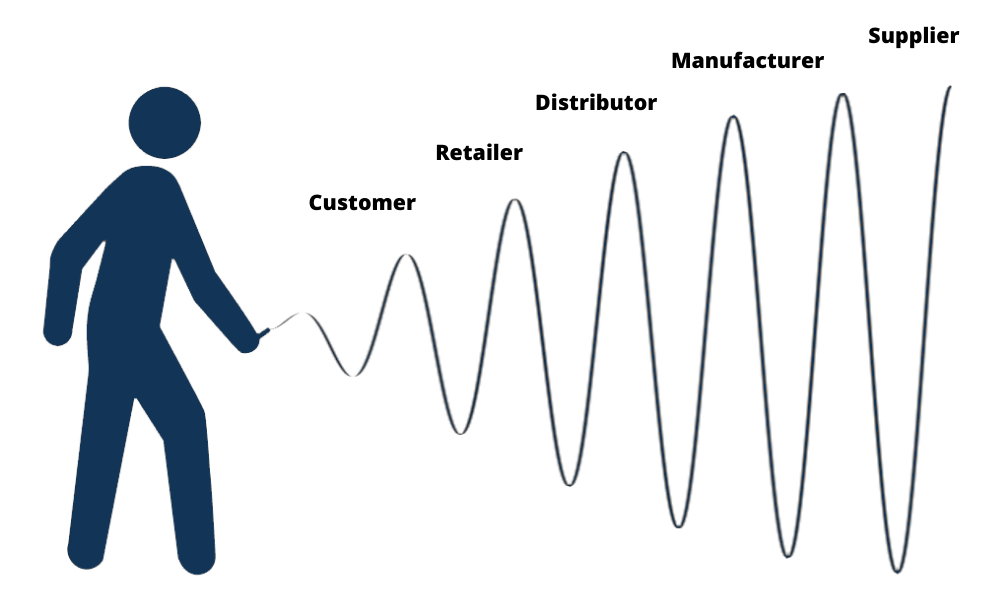5 Guidelines to Minimise the Bullwhip Effect on your Supply Chain
In a previous article, we discussed the phenomenon in supply chain called the Bullwhip Effect and why it matters to businesses and their supply chain.
To recap, the bullwhip effect is the unexpected distortion of a supply chain caused by a repetitive variation in demand. A typical supply chain is characterized by 5 key players – the customer, retailer, distributor, manufacturer and the supplier. A slight change in customer demand causes unplanned demand from the retailer, which oscillates to the distributor, manufacturer and finally to the supplier, magnifying through each level of the supply chain.

The bullwhip effect can lead to many problems in the supply chain which can prove costly to companies. Overstated or understated orders based on misguided forecasts can directly lead to incorrect inventory levels and damage customer relations due to unfulfilled orders and unavailable products. These mistakes should not be taken lightly as they can seriously affect the goodwill and profitability of a business.
That being said, how can businesses take caution to minimize the Bullwhip Effect on their supply chains? We have compiled 5 guidelines for businesses to consider.
1. Visibility and collaboration across stakeholders in the supply chain
Externally in the supply chain, the bullwhip effect can be minimized through better and more frequent information-sharing, ensuring improved communication along the supply chain.
.png?width=1000&name=%E6%9C%AA%E5%91%BD%E5%90%8D%E8%A8%AD%E8%A8%88%20(9).png)
All stakeholders in the supply chain should be aware of end customer needs, and companies in each tier are also aware of the outstanding inventory of their suppliers and customers. Internally, there should be effective communication and sharing of information between internal departments to prevent mis-ordering.
2. Optimize processes with technology
Business can consider investments in supply chain automation software to help optimize and streamline their supply chain processes, such as raw material planning, inventory planning and management, demand planning, and managing supplier relationships. For example, global sporting goods retailer Decathlon used Geek+ AMR sorting system to streamline Banggood’s e-commerce business.

Due to the accelerated shift towards e-commerce, Banggood faced challenges of rapid growth in online sales, unpredictable demand, labor shortages, and higher requirements for safer operations. With labor-intense processes often subject to inaccurate sorting, the company turned to Geek+ to automate its warehouse.

The implementation of Geek+ robots helped Banggood streamline its warehouse operations, reduce labor cost, improve sorting efficiency and accuracy.
3. Constant evaluation of inventorySupply chain leaders in businesses should consistently re-evaluate their safety stock settings and minimum-maximum stock range of each inventory point, and make adjustments if necessary. Businesses can consider adopting regular reporting and tools like early warning systems to help evaluate these factors.
.png?width=1000&name=%E6%9C%AA%E5%91%BD%E5%90%8D%E8%A8%AD%E8%A8%88%20(10).png)
4. Reduce lead time and delays
Reduction of order-to-delivery time can significantly reduce the risk of bullwhip effect. The quicker materials move through the supply chain to become finished products, the less inventory is accumulated. Businesses can consider to ship multiple types of items per truck or use 3PLs to continue to help save in shipping costs with smaller orders.

5. Reduce order sizes and offer stable forms of pricing
Businesses can also reduce their order sizes, which will enable them to respond to market activity with more speed and versatility. In addition, instead of offering frequent promotional discounts which may cause sudden distortions in demand, businesses can offer standard low prices (or everyday low prices).
.png?width=1000&name=%E6%9C%AA%E5%91%BD%E5%90%8D%E8%A8%AD%E8%A8%88%20(11).png)
To reduce the impact of the bullwhip effect on their supply chain, these are 5 guidelines which supply chain professionals can put into practice. Dilligent planning and execution of such best practices will ensure that your supply chain avoids the negative consequences of the bullwhip effect and improves its overall stability.
Let's click below button to learn how prepare your warehouse for robotic automation:
About Geekplus
Geekplus is a global leader in mobile robotics technologies. We develop innovative robotics solutions for order fulfilment. More than 850 global industry leaders use our solutions to realize flexible, reliable, and highly efficient automation for warehouses and supply chain management.
Media Contact
Marie Peterson, VP International Marketing & Communications
Marie.peterson@geekplus.com

